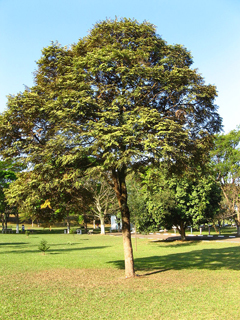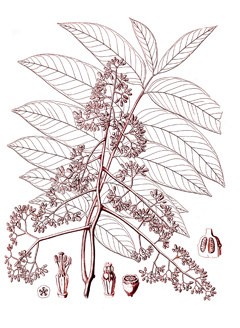 |
|
https://edibleplants.org/ |
 |
| https://edibleplants.org/ |
Translate this page:
Summary
Cedrela fissilis, otherwise known as Cedro, is a fast-growing tree native to Central and South America known for its high quality timber. It is deciduous and grows up to 20 ? 50 m tall. Its crown is dense and round and its trunk can reach up to 100 cm in diameter. Presently, it is considered to be an endangered species due to overexploitation and habitat losses. Medicinally, it is used in the treatment of leucorrhoea, ulcers, sores, and orchitis. Common names: Argentine cedar, cedro batata, cedro blanco, and cedro colorado
Physical Characteristics

 Cedrela fissilis is a deciduous Tree growing to 25 m (82ft) by 20 m (65ft) at a fast rate.
Cedrela fissilis is a deciduous Tree growing to 25 m (82ft) by 20 m (65ft) at a fast rate.
See above for USDA hardiness. It is hardy to UK zone 10 and is frost tender.
It is noted for attracting wildlife.
Suitable for: light (sandy), medium (loamy) and heavy (clay) soils and prefers well-drained soil. Suitable pH: mildly acid, neutral and basic (mildly alkaline) soils. It can grow in semi-shade (light woodland) or no shade. It prefers moist soil.
UK Hardiness Map
US Hardiness Map
Synonyms
Cedrela barbata C.DC. Cedrela brasiliensis A.Juss. Cedrela brunellioides Rusby.Cedrela elliptica Riz
Plant Habitats
Edible Uses
References More on Edible Uses
Medicinal Uses
Plants For A Future can not take any responsibility for any adverse effects from the use of plants. Always seek advice from a professional before using a plant medicinally.
Astringent Emetic Skin
The bark is astringent and emetic[ 46 , 739 ]. It has been recommended for the treatment of leucorrhoea, and is used as a dressing on ulcers[ 46 , 739 ]. A decoction of the wood is used as a wash for cleaning sores, and in a vapour bath to treat orchitis[ 739 ]. The fruits and the seed contain the limonoid triterpene fissinolide[ 739 ].
References More on Medicinal Uses
The Bookshop: Edible Plant Books
Our Latest books on Perennial Plants For Food Forests and Permaculture Gardens in paperback or digital formats.

Edible Tropical Plants
Food Forest Plants for Hotter Conditions: 250+ Plants For Tropical Food Forests & Permaculture Gardens.
More

Edible Temperate Plants
Plants for Your Food Forest: 500 Plants for Temperate Food Forests & Permaculture Gardens.
More

More Books
PFAF have eight books available in paperback and digital formats. Browse the shop for more information.
Shop Now
Other Uses
Fuel Pioneer Wood
Other uses rating: High (4/5). Agroforestry Uses: A very fast-growing tree that is tolerant of full sun, it can be used as a pioneer species when restoring native woodland and can also be used when establishing a woodland garden, though it should not be planted in homogeneous stands because it is susceptible to borers[ 419 ]. Other Uses The heartwood varies from pale pinkish-grey to deep reddish-brown with pronounced stripes and a high golden lustre; it is clearly demarcated from the 3 - 5cm wide band of whitish or yellowish-pink sapwood. The texture is moderately coarse; the grain straight or slightly interlocked; growth rings well demarcated; a characteristic fragrant scent is usually present; the taste is slightly bitter. The wood is light to moderately heavy; soft to very soft; it is very durable in dry conditions but it rots rapidly when buried or submerged, and is somewhat susceptible to termites. Soft tissue fairly abundant and found around the pores as well as in lines more or less parallel to the rings. Some cells are filled with resin. The timber seasons fairly rapidly with little or no splitting or warping if handled with care. Some tendency to collapse in drying may occur. It works easily with both hand and machine tools; the finish may be affected by interlocked grain and occasional gum pockets; in planing, 200 degree cutting angle will give a good finish; it has good gluing, nail holding and screw holding characteristics; stains and polishes well; slices readily. It is reported to have moderately good steam bending properties. The wood is widely used for making plywood, veneer, sculptures, models and frames, it is also used for cabinet making, high class furniture, naval and aircraft construction, railroad ties, canoes, general carpentry and pencils[ 46 , 341 , 419 , 848 ]. It is a moderately good fuel[ 341 ].
Special Uses
Food Forest
References More on Other Uses
Cultivation details
A plant of low to medium elevations in the tropics. Succeeds in full sun and also in moderate shade[ 381 , 419 ]. Prefers well-drained slopes on chalky soils[ 341 ]. Grows well on well-drained fertile soils[ 349 ]. A fast-growing tree, able to reach a height of 3 - 4 metres within 2 years from seed[ 419 ].
References Carbon Farming Information and Carbon Sequestration Information
Temperature Converter
Type a value in the Celsius field to convert the value to Fahrenheit:
Fahrenheit:
The PFAF Bookshop
Plants For A Future have a number of books available in paperback and digital form. Book titles include Edible Plants, Edible Perennials, Edible Trees,Edible Shrubs, Woodland Gardening, and Temperate Food Forest Plants. Our new book is Food Forest Plants For Hotter Conditions (Tropical and Sub-Tropical).
Shop Now
Plant Propagation
Seed - best sown as soon as it is ripe in a partially shaded position in a nursery seedbed or in individual containers. A very high germination rate can be expected, with the seed sprouting within 12 - 18 days[ 419 ]. The seedlings should be ready to plant out 2 - 4 months later[ 419 ]. Natural regeneration may be encouraged by clearing around seed trees[ 341 ].
Other Names
If available other names are mentioned here
Cedrela fissilis, otherwise known as Cedro. Common names: Argentine cedar, cedro batata, cedro blanco, and cedro colorado
Native Range
SOUTHERN AMERICA: Costa Rica (Limón), Panama, Venezuela (Barinas), Brazil (Bahia, Minas Gerais, Pará, Paraná, Rio Grande do Sul, Santa Catarina), Bolivia (El Beni), Colombia (Antioquia), Ecuador, Peru (Cusco, Huánuco, Loreto, San Martín), Argentina (Misiones, Salta, Tucumán)
Weed Potential
Right plant wrong place. We are currently updating this section.
Please note that a plant may be invasive in one area but may not in your area so it's worth checking.
None Known
Conservation Status
IUCN Red List of Threatened Plants Status : Status: Endangered A1acd+2cd

Growth: S = slow M = medium F = fast. Soil: L = light (sandy) M = medium H = heavy (clay). pH: A = acid N = neutral B = basic (alkaline). Shade: F = full shade S = semi-shade N = no shade. Moisture: D = dry M = Moist We = wet Wa = water.
Now available:
Food Forest Plants for Mediterranean Conditions
350+ Perennial Plants For Mediterranean and Drier Food Forests and Permaculture Gardens.
[Paperback and eBook]
This is the third in Plants For A Future's series of plant guides for food forests tailored to
specific climate zones. Following volumes on temperate and tropical ecosystems, this book focuses
on species suited to Mediterranean conditions—regions with hot, dry summers and cool, wet winters,
often facing the added challenge of climate change.
Read More
Expert comment
Author
Vell.
Botanical References
Links / References
For a list of references used on this page please go here
A special thanks to Ken Fern for some of the information used on this page.
Readers comment
| Add a comment |
|
If you have important information about this plant that may help other users please add a comment or link below. Only comments or links that are felt to be directly relevant to a plant will be included. If you think a comment/link or information contained on this page is inaccurate or misleading we would welcome your feedback at [email protected]. If you have questions about a plant please use the Forum on this website as we do not have the resources to answer questions ourselves.
* Please note: the comments by website users are not necessarily those held by PFAF and may give misleading or inaccurate information.
To leave a comment please Register or login here All comments need to be approved so will not appear immediately.
|
Subject : Cedrela fissilis
|
|
|
|